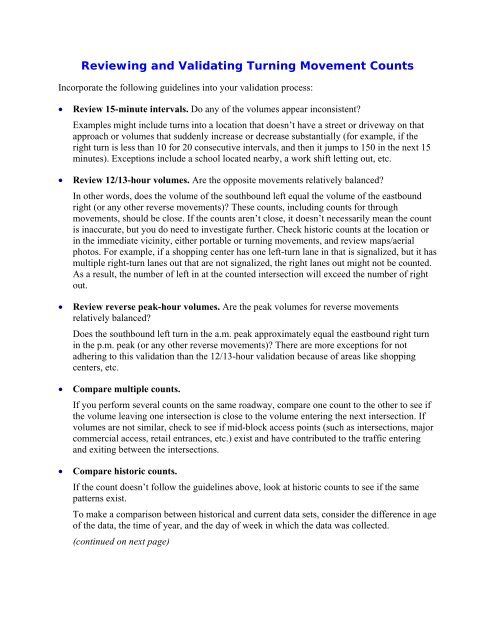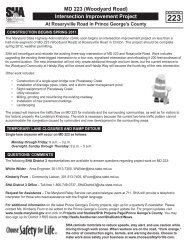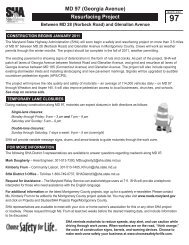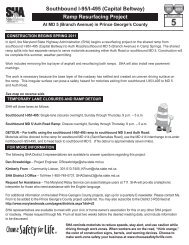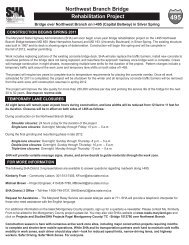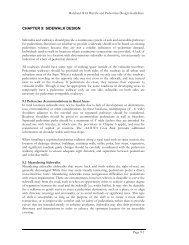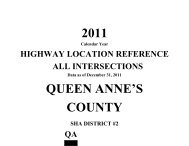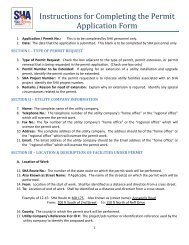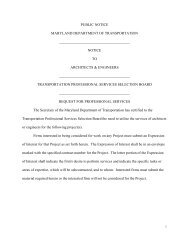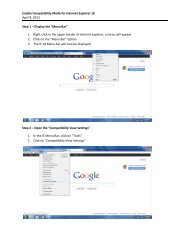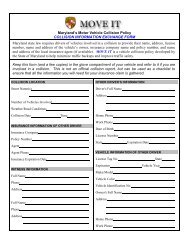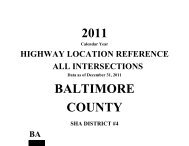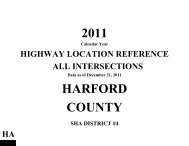Reviewing and Validating Turning Movement Counts
Reviewing and Validating Turning Movement Counts
Reviewing and Validating Turning Movement Counts
Create successful ePaper yourself
Turn your PDF publications into a flip-book with our unique Google optimized e-Paper software.
<strong>Reviewing</strong> <strong>and</strong> <strong>Validating</strong> <strong>Turning</strong> <strong>Movement</strong> <strong>Counts</strong><br />
Incorporate the following guidelines into your validation process:<br />
• Review 15-minute intervals. Do any of the volumes appear inconsistent?<br />
Examples might include turns into a location that doesn’t have a street or driveway on that<br />
approach or volumes that suddenly increase or decrease substantially (for example, if the<br />
right turn is less than 10 for 20 consecutive intervals, <strong>and</strong> then it jumps to 150 in the next 15<br />
minutes). Exceptions include a school located nearby, a work shift letting out, etc.<br />
• Review 12/13-hour volumes. Are the opposite movements relatively balanced?<br />
In other words, does the volume of the southbound left equal the volume of the eastbound<br />
right (or any other reverse movements)? These counts, including counts for through<br />
movements, should be close. If the counts aren’t close, it doesn’t necessarily mean the count<br />
is inaccurate, but you do need to investigate further. Check historic counts at the location or<br />
in the immediate vicinity, either portable or turning movements, <strong>and</strong> review maps/aerial<br />
photos. For example, if a shopping center has one left-turn lane in that is signalized, but it has<br />
multiple right-turn lanes out that are not signalized, the right lanes out might not be counted.<br />
As a result, the number of left in at the counted intersection will exceed the number of right<br />
out.<br />
• Review reverse peak-hour volumes. Are the peak volumes for reverse movements<br />
relatively balanced?<br />
Does the southbound left turn in the a.m. peak approximately equal the eastbound right turn<br />
in the p.m. peak (or any other reverse movements)? There are more exceptions for not<br />
adhering to this validation than the 12/13-hour validation because of areas like shopping<br />
centers, etc.<br />
• Compare multiple counts.<br />
If you perform several counts on the same roadway, compare one count to the other to see if<br />
the volume leaving one intersection is close to the volume entering the next intersection. If<br />
volumes are not similar, check to see if mid-block access points (such as intersections, major<br />
commercial access, retail entrances, etc.) exist <strong>and</strong> have contributed to the traffic entering<br />
<strong>and</strong> exiting between the intersections.<br />
• Compare historic counts.<br />
If the count doesn’t follow the guidelines above, look at historic counts to see if the same<br />
patterns exist.<br />
To make a comparison between historical <strong>and</strong> current data sets, consider the difference in age<br />
of the data, the time of year, <strong>and</strong> the day of week in which the data was collected.<br />
(continued on next page)
• Compare historic counts. (continued)<br />
Evaluate the counts for consistency in terms of the following:<br />
- Peak-hour time of day<br />
- Total peak-hour entering volumes<br />
- Total daily entering volumes (vehicular <strong>and</strong> pedestrian)<br />
- Total directional approach volumes<br />
- Peak-hour directional approach volumes<br />
- Quick research on major developments in the area since the last count was taken that<br />
would affect the traffic volumes at the intersection<br />
- Quick research on roadway improvements in the area that would affect the intersection<br />
volumes<br />
• Analyze Critical Lane Volume (CLV).<br />
CLV worksheets are not automated because they have to accommodate many different<br />
intersection configurations, like special treatment for right <strong>and</strong> left turns. Typical checkpoints<br />
include the following:<br />
- Right-Turn Overlap, Free Right Turn, <strong>and</strong> Right Turn on Red (RTOR)<br />
- Lane Configuration<br />
- Volumes <strong>and</strong> Opposing Volumes<br />
- Passenger Car Equivalency Factors<br />
- Lane Use Factors <strong>and</strong> De Facto Lanes<br />
- Signal Phasing<br />
- Calculation Errors (in spreadsheet formulas)<br />
- Does the LOS match the existing field conditions (for example, F = congested<br />
operations)?<br />
2


